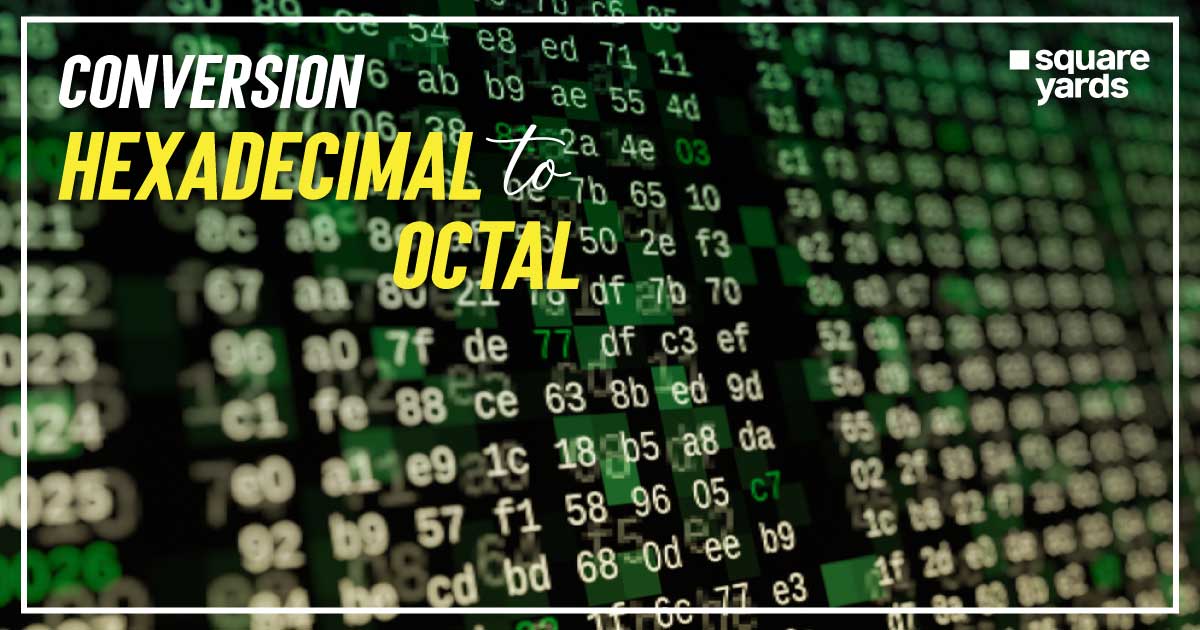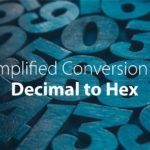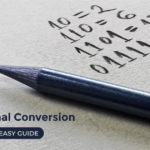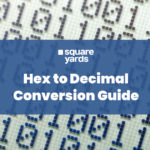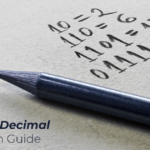We know there are four types of number systems: hexadecimal, octal, binary, and decimal. As per the number system, these numbers can change their forms. To convert hexadecimal numbers to octal numbers, we must first convert each hexadecimal number to its matching decimal number. Before starting this hexadecimal to octal conversion, let’s review the definitions of octal and hexadecimal numbers.
Table of contents
What is Hexadecimal?
Hexadecimal numbers are base-16 numbers. There are 16 different digits used to represent the numbers. Its hexadecimal representation is h16. There are both letters and digits present in their form. As a result, it contains the numbers 0 to 9 and the letters A to F.
Current Use of Hexadecimal
Hexadecimal is frequently used in machine code and assembly programming languages. It is used frequently when discussing memory addresses. Additionally, it can represent numbers saved in a CPU’s register or main memory during the reforming stage of programming.
History of Hexadecimal
In 1963, IBM became the first company to use the modern hexadecimal approach in computing. The Bendix G-15 computer utilised an older form in 1956, including the digits 0 through 9 and the letters u–z in lower case.
In the early history of computers, not all numerals greater than nine were represented by the letters A through F. Some facilities preferred using the numerals 0 to 5 and the macron character (” “) to represent 10-15 values during the 1950s. Some mathematicians disagreed with the theory, nevertheless. In a 1968 letter to the editor of the CACM, Bruce A. Martin of the Brookhaven National Laboratory offered an entirely new set of symbols based on bit positions since he found the decision to use the letters A–F somewhat irrational. His proposal did not meet with much success.
What is Octal?
The octal number system has an 8 base. Since they have 8 digits, ranging from 0 to 7, these are called octal numbers. Its sign is o8, where o represents the octal number. The numbers 8 and 9 are not represented by it.
Current Use of Octal
The computer application industries extensively use the Octal Number system. All computer systems of the present generation use 16-bit, 32-bit, or 64-bit words that are further broken into 8-bit words. Using octal numbers as a code is also common in the aviation industry.
History of Octal
When counting animals from eight to eight in the past, humans used their hands, which is where the octal system started.
James Anderson berated the French in 1801, accusing them of constructing the metric system using decimal arithmetic. He proposed base 8 and proposed the name “octal” for it. Also, the octal numbering system predated the decimal system to count interdigital gaps or all fingers other than the thumb.
Because the binary system requires several digits to express just one number, it was later replaced by the octal numbering system, which can be readily translated to the binary system. The hexagonal and octal systems were also developed after that.
Relationship Between Hexadecimal and Octal
Octal and hexadecimal number systems have been developed to read huge binary numbers in computer languages. Hexadecimal and octal are related by their respective numerical foundations. While octal utilises base-8 and the numbers 0-7, hexadecimal uses base-16 with the digits 0-9 and the letters A-F. Both are necessary for effectively describing data in computer systems. To convert between them, numbers and symbols must be grouped in a particular way. This makes it simple to swap programming and data storage representations as needed.
How to Convert Hexadecimal to Octal?
Hexadecimal cannot be easily converted to octal. We must first translate hexadecimal into its corresponding decimal number, then from decimal to octal. Adhere to the procedures below to comprehend the hexadecimal to octal converter methods.
Method 1
- Pick a given hexadecimal number.
- Count the digits of the given number.
- In case you find that n is the form of the digit through the right end, then you must multiply every digit by 16.
- Next to the multiplication, you can simply add the terms.
- You can see the result in the decimal form.
- Now just divide the resultant decimal number by 8.
- Jot down the digit of the remainder.
- Up until the quotient is zero, repeat the first two steps using the quotient.
- Now jot down the digit of the remainder in the reverse order.
- Consider the acquired number as a result.
Method 2
Since binary digits are included in hexadecimal numbers; we can group these binary numbers into a pair and compare them to octal numbers. It is another way to convert any hexadecimal to its octal counterpart. Let’s examine the procedure using steps and an example:
- Write the binary number corresponding to each digit in the supplied hexadecimal integer. Add 0s to the left side if any binary equivalents have less than four digits.
- Combine and create the three-digit binary groups from right to left. If the final group has fewer than three digits, move 0s to the left.
- Each binary group’s octal equivalent should be found.
Formula and Examples of Hexadecimal to Octal Conversion
The process of translating a number from base-16 to base-8 is known as hexadecimal to octal conversion. Simple steps must be taken to divide the hexadecimal number into groups of three digits and then to translate each group into its octal equivalent.
Hexadecimal to Octal Formula of Conversion
Starting with the rightmost digit, divide the hexadecimal digits into three-digit sets. Add zeros from the left if the final group contains fewer than three numbers. Now, use the following table to translate each group into its octal equivalent:
Hexadecimal – Octal
- 0 – 0
- 1 – 1
- 2 – 2
- 3 – 3
- 4 – 4
- 5 – 5
- 6 – 6
- 7 – 7
- 8 – 10
- 9 – 11
- A – 12
- B – 13
- C – 14
- D – 15
- E – 16
- F – 17
Instances of Hexadecimal to Octal Conversion:
Example 1.
Condition: Convert 3EF16 into an octal number
Solution: 3EF16 is a hexadecimal number
Now arrange them from right to left, each holding 3 digits.
F16 → 3178, E16 → 3168, 3 → 0038.
Therefore, 3EF16 = 003316178.
Example 2.
Condition: Convert 1F16 into an octal number
Solution: F16 = (F × 160)
= F × 1
= F
= 15 (Decimal form)
Now easily convert this decimal to an equivalent octal number;
The octal number is 178
Hence, F16 = 178
Example 3.
Condition: Convert 10516 into an octal number
Solution: Given a hexadecimal number is 105.
10516 = (1 × 162) + (0 × 161) + (5 × 160)
= 1×256 + 0 × 16 + 5 × 1
=256 + 0 +5
= 261 (Decimal form)
Now simply convert this decimal to equivalent octal;
The octal number is 4058
Hence, 10516 = 4058
Example 4.
Condition: Convert C116 into an octal number
Solution: C116 is a given hexadecimal number
C116 = (C × 161) + (1 × 160)
= C × 16 + 1 × 1
=12 × 16 + 1
= 192 + 1
C116 =193 (Decimal form)
Now we have to convert this decimal to octal number;
The octal number is 3018
Hence, C116 = 3018
Don’t miss It!
| Kilometer to Centimeter | Kilometer to Centimeter Conversion: Conversion Table, Examples |
| Centimeter to Meter | How to Convert Centimeter to Meter: Formula & Examples |
| Cubic Meter to Liter | How to Convert Cubic Meter to Liter: Formula & Examples |
| Cent to Square Feet | How to Convert Cent to Square Feet: Formula & Examples |
| Pounds to Kilogram | How to Convert Pounds to Kilogram: Formula & Examples |
| Milligrams to Grams | How to Convert Milligramsto Grams: Formula & Examples |
| Yard to Feet | How to Convert Yard to Feet Formula & Examples |
| Binary to Decimal | How to Convert Binary to Decimal: Formula & Examples |
Conversion Table of Hexadecimal to Octal
| Hexadecimal | Octal | Equivalent Decimal | Equivalent BInary |
| 0 | 0 | 0 | 0 |
| 1 | 1 | 1 | 1 |
| 2 | 2 | 2 | 10 |
| 3 | 3 | 3 | 11 |
| 4 | 4 | 4 | 100 |
| 5 | 5 | 5 | 101 |
| 6 | 6 | 6 | 110 |
| 7 | 7 | 7 | 111 |
| 8 | 10 | 8 | 1000 |
| 9 | 11 | 9 | 1001 |
| A | 12 | 10 | 1010 |
| B | 13 | 11 | 1011 |
| C | 14 | 12 | 1100 |
| D | 15 | 13 | 1101 |
| E | 16 | 14 | 1110 |
| F | 17 | 15 | 1111 |
Difference Between Hexadecimal and Octal
| Hexadecimal | Octal |
| Hexadecimal utilises 16 digits or different symbols, depicting the hexadecimal numbers [0,1, 2, 3, 4, 5, 6, 7, 8, 9, A, B, C, D, E, F]. | Octal utilises 8 digits or different symbols to depict the octal numbers. Thereby, it has digits starting from 0 to 7 only. |
| The base or a radix of the hexadecimal number is 16. | The base or a radix of the octal number is 8. |
| It is easy to depict the hexadecimal number and to remember the big numbers. | It is easy to depict octal numbers but tough to recall big numbers. |
| Example of a hexadecimal number: FF, which equals 250 in decimal. | An example of a binary number is 377 (equal to 255 in decimal). |
| A single Hexadecimal digit is represented by 4 bits or 4 Binary digits. | An Octal digit can be represented using 3 bits or 3 Binary digits. |
| The 16-digit hexadecimal number system makes complicated arithmetic and logical processes possible. | The Octal number system, on the other hand, only uses eight digits. Compared to the hexadecimal number system, arithmetic and logical operations are simple. |
| The hexadecimal number format makes it simpler to represent huge decimal figures. | It gets challenging and complicated to represent huge decimal numbers in octal. |
In a Nutshell
In conclusion, a thorough understanding of the hexadecimal to octal conversion procedure is essential for effective data representation in computer systems. Because of the link between hexadecimal base-16 and octal base-8, programming and data storage can easily switch between the two. Users can quickly transition between various number systems by properly arranging the numbers and symbols. By mastering this conversion, programmers and data handlers can increase productivity in various computing jobs. Skipping to the good part, you can now use the hexadecimal to octal calculator and avoid performing tough conversion formulas.
FAQ’s about Hexadecimal to Octal
Q1. How to convert hexadecimal to octal?
Look at the given hexadecimal value, then count the numbers in the given digit, making sure that each of the digits can be multiplied by 16n-1. Now, you can add the terms later by multiplying them. You’ll see that the result will come into equivalent decimal format; now, to convert hexadecimal to octal, simply divide the decimal with 8.
Q2. What is 123 octal in hexadecimal?
The 123 octal is equal to 53 hexadecimal.
Q3. What is 145.23 octal in hexadecimal?
Therefore, 65.4C is the octal number 145.23’s counterpart in Hexadecimal.
Q4. How to convert octal to hexadecimal?
It is standard procedure to convert an octal number to a binary digit, then from the binary representation to the hexadecimal representation. We now combine the four binary bits to obtain their hexadecimal equivalent. The hexadecimal code for 536 is 15E.03.


